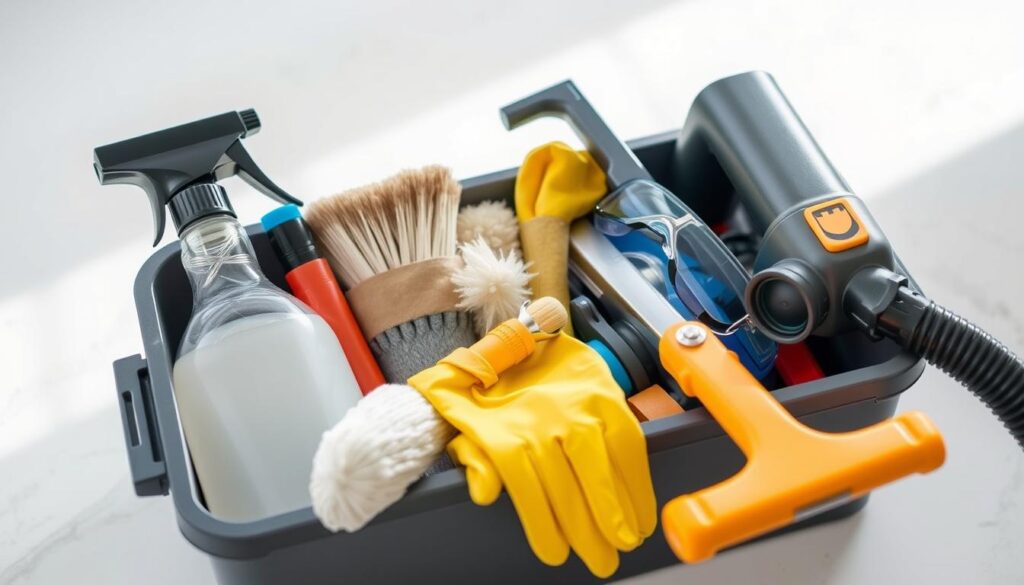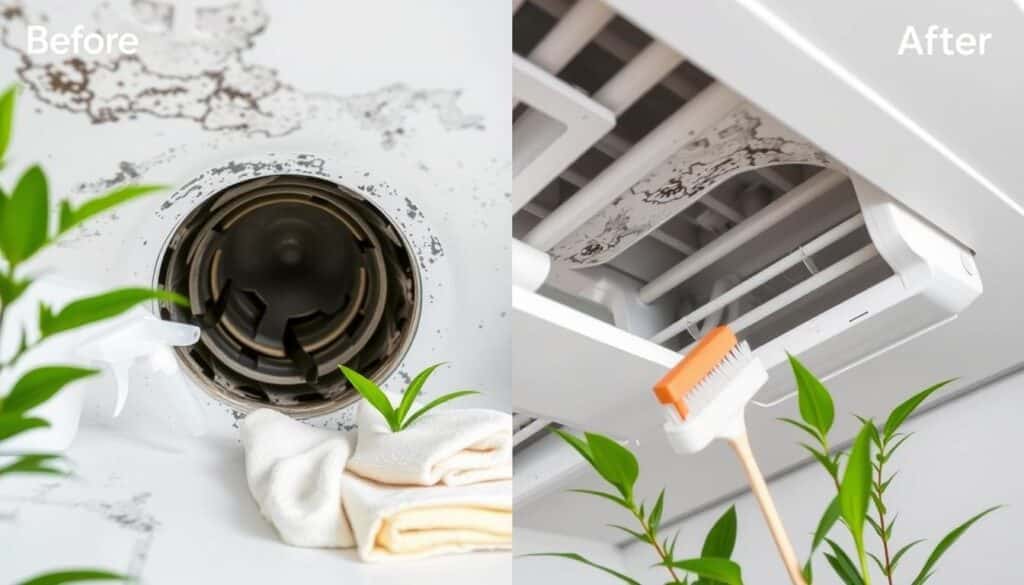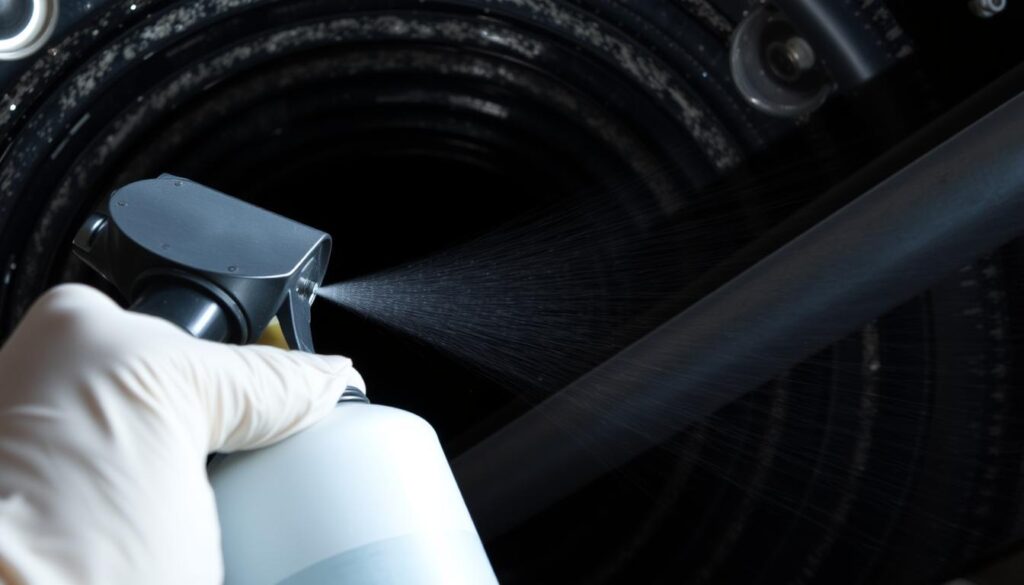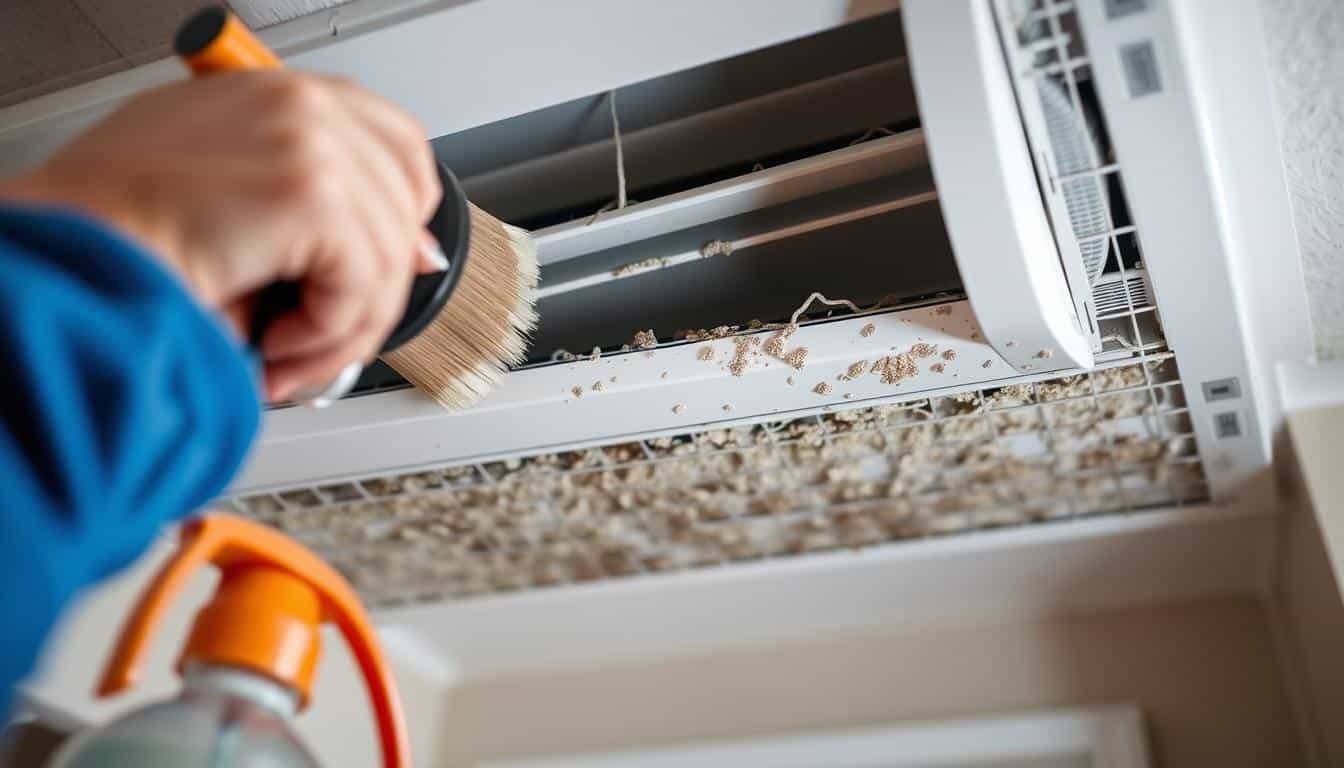Did you know that removing mold from AC ducts can cost up to $2,000 with a pro? But, you can do it yourself with the right tools and steps. This guide will show you how to remove mold from your air conditioner ducts. It’s a way to save money and keep your home healthy.
Key Takeaways
- Mold in air ducts can cause respiratory issues like coughing, wheezing, and shortness of breath.
- DIY mold removal is possible with the right cleaning agents and protective gear.
- Regular HVAC inspections and maintenance can help prevent mold growth in the future.
- Professional assistance may be needed for extensive mold infestations or complex HVAC systems.
- Addressing moisture issues and maintaining proper humidity levels are key to preventing mold.
Introduction: The Importance of Removing Mold from AC Ducts
Mold in your AC ducts can be very harmful, especially for people with asthma or allergies. These tiny fungi can spread through your HVAC system. This makes the air you breathe every day dirty. Knowing the signs of mold and what it looks like is key to keeping your home clean.
Signs of Mold Growth in Your HVAC System
A musty smell is a common sign of mold in AC ducts. If your system smells bad when it’s on, there might be a problem. Also, if you get allergy-like symptoms like sneezing or headaches when the AC is on, mold spores might be in your air.
What Does AC Duct Mold Look Like?
Finding mold in AC ducts can be hard because it’s not always easy to see. But, if you spot black, slimy spots that won’t go away, it’s mold. This kind of mold, called “black mold,” is very dangerous and needs to be fixed fast.
Not dealing with mold in your HVAC system can be very bad. Mold in AC ducts can cause health problems like breathing issues, allergies, and even worse. It’s important to find and remove mold from your air ducts to keep your home safe and healthy for everyone.
Tools and Materials Needed for Duct Mold Removal
To remove mold from your air conditioning ducts, you need the right Tools for Mold Removal in Air Ducts. A sturdy scrub brush helps dislodge mold, while a HEPA vacuum captures spores. You’ll also need a screwdriver to remove air vent covers.
It’s crucial to wear Protective Gear for Duct Cleaning to stay safe. This includes an N-95 mask, thick gloves, safety goggles, and a coverall. For cleaning, have rags or cloths ready.
The EPA suggests hiring professionals for big mold jobs. But for smaller issues, you can do it yourself with these tools and supplies. Being well-equipped helps you remove mold from your HVAC system and stop it from spreading.
Tools
- Scrub brush
- HEPA vacuum
- Screwdriver
Materials
- Rags or cloths
- N-95 mask
- Industrial-strength gloves
- Safety goggles
- Coverall
With the right tools and protective gear, you can safely remove mold from your air conditioning ducts. This makes your home or business healthier.

Preparing for Mold Removal in Air Ducts
Before you start removing mold from your air ducts, it’s important to prepare. The right steps ensure a safe and effective process. Let’s look at how to prepare for Air Duct Mold Removal.
- Equip Yourself: Wear the right personal protective equipment (PPE). Use a high-quality N95 or P100 mask, gloves, and eye protection to protect yourself from mold spores.
- Power Down: Turn off your HVAC system before starting. This stops the mold from spreading further in your home.
- Vacuum the Vents: Clean the air vents with a HEPA vacuum. This removes any loose mold spores.
- Contain the Area: Seal off the work area with plastic sheeting. This prevents mold spores from spreading to other parts of your home.
- Gather Cleaning Supplies: Get the cleaning materials you need, like antifungal solutions, scrub brushes, and microfiber cloths. These will help you tackle the mold effectively.
By following these steps, you’re on your way to a successful DIY duct mold cleaning. Always prioritize your safety when dealing with mold in your home.
| Statistic | Percentage |
|---|---|
| Mold problems requiring professional intervention | 18% |
| Mold growth that can be prevented by controlling moisture and ventilation | 75% |
| Mold spores captured by HEPA filters | 99.97% |
| Accuracy of professional mold inspections in identifying moisture and mold sources | 90% |
| Reduction in mold occurrence with regular HVAC maintenance | 60% |
| Mold and bacteria killed by UV lights in HVAC systems | 99.9% |
| Decrease in condensation from properly sealed and insulated ductwork | 80% |
By taking these steps and using the right tools, you’ll have a successful and safe mold removal. A little preparation can make a big difference in keeping your indoor environment clean and healthy.
Remember, while DIY mold removal can work, it’s best to get professional help if the problem is big or if you’re unsure about your safety or HVAC system.
How to Remove Mold from Air Conditioner Ducts
Mold in air conditioning ducts is a common problem. It can make indoor air unhealthy and harm your health. Luckily, there are DIY duct mold removal techniques to fix this issue.
Using Bleach Solution
Using a bleach solution is a popular Effective Mold Cleaning Method for Air Ducts. Mix 1 part bleach with 16 parts water. Use this mix to soak vent grills and scrub moldy areas inside ducts.
Remember to turn off the AC unit and breaker first. Let the solution dry completely before putting the vents back.
Dish Soap Method
Another DIY Duct Mold Removal Technique is dish soap. Mix a few drops of dish soap in warm water. Clean vent grills and scrub moldy spots with this Homemade Mold Cleaning Solution.
Laundry Detergent Approach
For a strong Homemade Mold Cleaning Solution, mix laundry detergent with water. The detergent’s agents can break down and remove mold. Scrub well, vacuum the ducts, and let them dry before putting the vents back.
Baking Soda and Detergent Mixture
A mix of baking soda and detergent is also effective. Make a paste with these ingredients. Apply it to moldy spots, let it sit, then scrub and vacuum the ducts clean.
It’s crucial to clean and dry ducts well to stop mold from coming back. Regular HVAC system checks and maintenance can help keep your indoor air healthy.

“Mold growth in air ducts can have serious health consequences, so it’s important to address the issue promptly and effectively.”
Renting a Mold Removal Fogger Machine
Renting a mold removal fogger machine can change the game for tackling mold in your HVAC ducts. These devices make a fine mist of EPA-registered disinfectants. This mist can reach and kill mold spores in hard-to-reach areas.
The fogging method for duct mold remediation uses micro-droplets to cover large areas. These EPA-registered disinfectant foggers create droplets between 5-50 microns. This ensures they cover everything well and kill mold and other pathogens effectively.
Unlike old cleaning methods, renting a mold fogger for HVAC ducts lets you clean the toughest spots. The mist stays in the air for up to 10 minutes. This means the disinfectant solution spreads evenly and thoroughly.
When picking a mold fogger, choose electric or battery-powered ones. Gasoline-powered models can release harmful fumes, make a lot of noise, and are a fire hazard. They’re not safe for indoor use.
Fogging should be part of a bigger mold removal plan. It should work with physical cleaning and fixing moisture problems. Using a fogger can make your mold removal efforts more complete and effective.
“Fogging is not a substitute for proper mold remediation, but it can be a valuable tool in the process.” – Environmental Hygienists Association
When renting a mold removal fogger, look for adjustable droplet size, coverage area, and easy use. Popular choices include the EC3 Sanitizer Fogger, Vectorfog C100 ULV Electric Fogger, and Fogmaster Tri-Jet 6208. These models are made for efficient mold control in HVAC systems.
Post-Cleaning Steps and Mold Inhibitor Application
After cleaning mold from your air conditioner ducts, applying a mold inhibitor is key. This step Applying Mold Inhibitors After Duct Cleaning stops future Preventing Mold Regrowth in HVAC mold. It keeps your HVAC system clean and working well.
Read the instructions for your mold inhibitor carefully. These products make it hard for mold to grow, Post-Mold Removal Treatment stopping it from coming back. Use the inhibitor on all parts of your HVAC system, like ducts, coils, and mold-affected areas.
Also, replace your air filters. Old filters might have mold spores that can spread back into your system. New filters bring in clean, mold-free air.
| Step | Action |
|---|---|
| 1. Apply Mold Inhibitor | Follow manufacturer’s instructions to apply mold inhibitor throughout HVAC system |
| 2. Install New Air Filters | Replace old air filters to prevent recirculation of mold spores |
By following these steps and using a mold inhibitor, you’ll keep your HVAC system mold-free. This ensures your home’s climate control stays healthy and efficient.

How to Remove Mold from Air Conditioner Ducts
Causes of Mold Growth in AC Ducts
Mold is common in HVAC systems, especially in warm, moist places. Air conditioning ducts are perfect for mold to grow. Types like aspergillus niger can harm your air quality and health.
Inside air ducts, warm, humid air and poor air flow cause moisture. This moisture is great for mold. Leaks in the HVAC system make things worse by adding more moisture.
Controlling Moisture to Prevent Mold
To stop mold in AC ducts, you need to fix the root problems. Keeping your HVAC system in good shape helps. Change air filters every three months to reduce mold risk.
Insulating ducts can also help by reducing moisture. Using EPA-registered mold inhibitors can control mold. Fixing HVAC leaks and improving air flow are also key.
Adding UV lights or ionization air purifiers in ducts can kill odors and stop mold. These steps help keep your air clean and your home healthy.
| Causes of Mold in AC Ducts | Moisture Control Strategies |
|---|---|
|
|
By controlling moisture and fixing mold causes, you can stop mold in air ducts. This keeps your home healthy and clean.
Professional Mold Remediation Services
Dealing with mold in your air conditioning ducts often requires professional help. Hiring Professional HVAC Mold Removal is wise if the mold is widespread or hard to reach. DIY efforts can spread mold spores, making health issues worse.
The Cost of Professional Duct Mold Cleaning varies from $500 to $2,500. This depends on how much cleaning is needed, where you live, and the company’s experience. Experts use special methods and EPA-approved products for safe and effective mold removal.
The Benefits of Professional Mold Remediation include:
- Comprehensive mold testing and inspection to identify the full extent of the problem
- Use of advanced cleaning methods and antimicrobial solutions to effectively kill mold
- Proper containment and disposal of mold-contaminated materials to prevent cross-contamination
- Expertise in identifying and addressing the root causes of mold growth to prevent recurrence
- Compliance with industry standards and regulations for safe mold remediation
Choosing a professional like PuroClean ensures your home is safe. DIY duct cleaning can spread mold, risking your health and home damage. Let experts handle it for a lasting solution.
“Mold exposure can lead to a variety of health issues, from respiratory problems to allergic reactions. It’s crucial to address any mold growth in your HVAC system promptly and effectively to protect your family’s wellbeing.”
| Service | Average Cost | Includes |
|---|---|---|
| Professional HVAC Mold Removal | $500 – $2,500 |
|
Maintaining a Mold-Free HVAC System
Keeping your HVAC system mold-free is key for your home’s health and comfort. Regular checks, controlling humidity, and good ventilation are vital. Also, upgrading insulation around air ducts helps a lot in preventing mold.
Regular HVAC Inspections
Get your HVAC checked every six months by a trusted company. They can spot and fix issues that might cause mold. This way, your system stays efficient and mold-free.
Humidity Control and Proper Ventilation
Mold loves warm, humid places. So, it’s important to keep humidity low. Use a dehumidifier and make sure your home is well-ventilated. This stops mold from growing.
Upgrading Insulation
Improving or replacing insulation in air ducts helps a lot. It stops condensation and reduces mold risk. Good insulation keeps duct temperatures stable, making it hard for mold to grow.
By taking these steps, you can keep mold out of your air ducts. Regular care and attention are crucial for clean air and comfort in your home.
| Mold Prevention Tip | Benefit |
|---|---|
| Bi-annual HVAC inspections | Identify and address issues before mold growth occurs |
| Maintain indoor humidity below 60% | Discourage mold growth by controlling moisture levels |
| Ensure proper ventilation | Prevent condensation and reduce the risk of mold |
| Upgrade insulation around air ducts | Maintain stable temperatures and minimize condensation |
By taking these steps, you can keep your HVAC system mold-free. This protects your home’s health and comfort.
“Mold can start to grow in HVAC systems within as little as 48 hours, emphasizing the need for regular checks.”
Conclusion
Removing mold from your air conditioning ducts is key to keeping your family safe and healthy. This guide shows you how to clean and stop mold in your HVAC system. Always wear the right gear, use the correct cleaning solutions, and think about getting a pro for big problems.
The Summary of Duct Mold Removal Process and Key Takeaways help keep your air clean. Regular checks, controlling humidity, and good ventilation are vital for your home’s air quality and health.
Being proactive and following best practices can fight mold in your air system. This makes your home healthier and more comfortable for your family. Remember, tackling mold is an investment in your home and loved ones’ well-being.
FAQ
What are the signs of mold growth in my HVAC system?
Signs of mold in your HVAC system include a musty smell and allergy-like symptoms. You might also experience headaches, dizziness, and nausea. Look for visible mold or black spots on air vents.
What does mold in AC ducts look like?
Black mold that’s hard to wipe away and looks wet and slimy is a serious issue. It means you have a big problem in your air ducts.
What tools and materials do I need to remove mold from my air ducts?
You’ll need a scrub brush, HEPA vacuum, and a screwdriver to unscrew vents. Don’t forget protective gear like an N-95 mask, gloves, goggles, and a coverall. You’ll also need rags or cloths.
How do I prepare for mold removal in my air ducts?
First, put on your protective gear. Then, turn off your AC or heating unit. Use a HEPA vacuum to remove loose mold spores from the air vents.
What are the DIY methods for cleaning mold from air ducts?
You can use a bleach solution, dish soap in warm water, or laundry detergent. A baking soda and detergent mixture also works well.
What is a mold removal fogger, and how can it help?
After cleaning the ducts, use an EPA-registered disinfectant fogger. It kills any remaining mold spores. These devices create a mist that thoroughly cleans your ducts.
What should I do after cleaning the mold from my air ducts?
After cleaning, follow the manufacturer’s instructions for applying a mold inhibitor. This will prevent new mold growth. Also, install new air filters.
What causes mold growth in air conditioner ducts?
Mold grows in ductwork due to moisture and warm temperatures. High humidity and poor ventilation lead to condensation and mold.
How can I prevent mold from growing in my air ducts?
To prevent mold, replace HVAC filters regularly and insulate air ducts. Clean condensate/drip pans and address any leaks. Use EPA-registered mold growth inhibitors.
When should I hire a professional for duct mold removal?
If you see mold but it’s extensive or hidden, get a professional HVAC contractor. Trying to handle it yourself can spread mold and harm your health.




